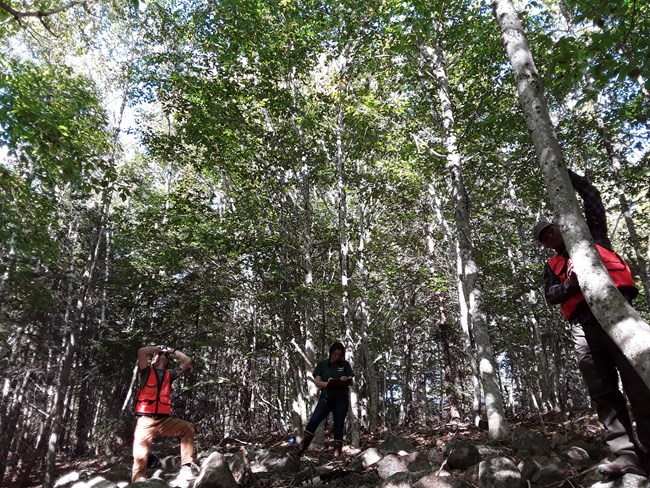Last updated: January 12, 2022
Article
Research Brief: Surveying for Beech Leaf Disease

Jesse Wheeler, NPS
Dr. Cameron McIntire, Forest Pathologist, USDA Forest Service
What does your research hope to answer/investigate?
The US Forest Service is investigating the extent and severity of beech leaf disease. The disease is caused by a non-local introduced worm, that eats the leaf, causing dark bands, a crinkling appearance, and leathery texture. Diseased stands can suffer from defoliation and canopy dieback, which tends to increase in severity following multiple years of infection. We have established a monitoring plot at Acadia as part of a regional network to collect information about tree health and local factors, such as forest characteristics and climate that may be relevant to the spread and severity of beech leaf disease. Survey and monitoring are a core component of understanding emerging diseases and will ultimately be useful for determining best practices for mitigation and management.
For more information on Beech Leaf Disease, see the recently updated Pest Alert.
Please describe your process for investigation? Are there clear stages or benchmarks that your research project will have along the way?
Long-term datasets are essential for tracking the progression of tree diseases and the condition of forest health. During the 2021 growing season a tenth-acre permanent monitoring plot was established within a stand of American beech (Fagus grandifolia) on Mount Desert Island. Within the plot, tree attributes such as stem diameter, foliar density, and canopy dieback are measured by trained forestry professionals. A detailed canopy assessment is used to approximate the abundance of leaves showing varying effects of beech leaf disease. We are also monitoring beech bark disease associated with scale insect (Cryptococcus fagisuga) and fungal canker (Neonectria spp.) in the hopes of understanding interaction of leaf and bark diseases in American beech. The monitoring plots are remeasured once annually during the growing season by the US Forest Service and cooperators with the Maine Forest Service.
How does this research apply to what we might know about or how we might manage Acadia National Park?
Beech leaf disease was first detected in Maine in 2021 on private property in Waldo County. So far, the outbreak appears to be confined to the midcoastal region of the state, with additional positive detections in Knox and Penobscot counties. Given the close proximity to Acadia National Park, we wanted to establish a monitoring plot within the park to assess forest condition and collect baseline data. As of September 2021, Beech leaf disease has not been detected within Acadia. Given the abundance of American beech within the park, it is important to monitor this resource as beech leaf disease continues to spread throughout the region. Managing for forest pathogens if often difficult, as most traditional chemical treatments target individual trees and cannot be realistically applied to large, forested areas. In some cases, silvicultural prescriptions may be used to buffer disease to reduce spread and severity. As more information about beech leaf disease becomes available, such as the mode of transmission, we will recommend appropriate management practices.
How does this project help contribute to scientific understanding or management solutions beyond Acadia?
USFS Forest Health Protection works with National Forest System lands, and cooperates with other federal agencies, tribes, states, and others to protect forest and tree health by managing insects, pathogens, and other damage-causing agents. American beech is a major component of mixed hardwood forests throughout the northeastern United States. Though the presence of beech bark disease has significantly reduced wood quality and the potential for valuable timber products, beech is still regarded as an important ecological resource. Deer, bear, and many small mammals incorporate beech nuts as a major carbohydrate in their diets. Beech is also among the most shade tolerant hardwood species in the region, making it crucial structural element of the forest habitat. The monitoring plot established at Acadia will provide a valuable data point for evaluating the potential impact of beech leaf disease on a regional scale, which will be used to inform best practices for management throughout the range of American beech.
